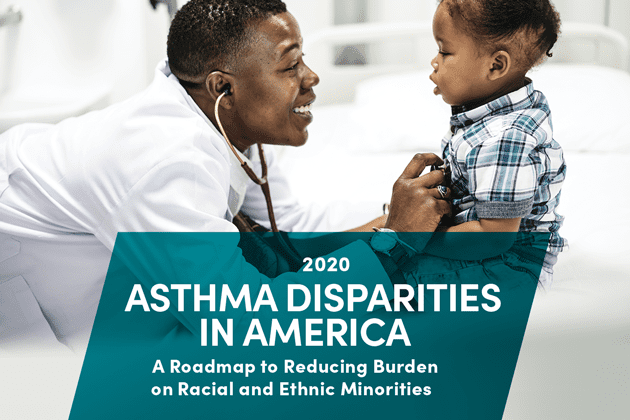Research & Reports
Food Allergy Anaphylaxis in Infants and Toddlers
The Asthma and Allergy Foundation of America (AAFA) conducted a study on anaphylaxis in infants and toddlers: the AAFA Infant Toddler Anaphylaxis (ITA) Study. Anaphylaxis is a severe allergic reaction that can be life-threatening if not treated quickly and properly.
The most common causes of anaphylaxis are food, latex, insect stings and bites, and medicines. Food is the most common cause of anaphylaxis in young children. If someone has a severe allergic reaction, the first line of treatment is epinephrine. Epinephrine is safe and works quickly to stop serious symptoms of an allergic reaction.
Anaphylaxis can be hard to recognize in infants and toddlers. It’s important for parents and caregivers to know the signs and symptoms in young children and when to give epinephrine.
About the Study
AAFA worked with leading food allergy researchers to better understand how parents and caregivers recognize and treat severe allergic reactions (anaphylaxis) in infants and toddlers. Results from this study are published in the Journal of Allergy and Clinical Immunology: In Practice.
Key Findings
AAFA surveyed 374 caregivers of children who had an allergic reaction to food when younger than 3 years old. AAFA defined anaphylaxis as a reaction with symptoms affecting two of five organ systems, with at least one of them being impacting the airways or heart and blood vessels. These important key findings came from AAFA’s ITA study:
1. Signs and Symptoms of Anaphylaxis in Infants and Toddlers May Differ from Older Children and Adults
The ITA study identified signs and symptoms of anaphylaxis that are specific to infants and toddlers and recognized by parents/caregivers. The most common symptoms of anaphylaxis in infants and toddlers were skin reactions, swelling, vomiting, and diarrhea. Signs related to the heart and blood vessels – like blue-grey-white appearance and poor head control – were not as common as skin or stomach/gut issues.
Compared to older children and adults, infants and toddlers are more likely to have:
- Itching
- Rash
- Hives
- Vomiting
- Diarrhea
- Hoarse voice/cry
- Sudden behavioral change
Compared to older children and adults, infants and toddlers are less likely to have:
- Increased breathing rate
- Trouble breathing
- Itchy throat
The ITA study also found that parents/caregivers recognized signs that they later realized were due to an allergic reaction. More education is needed on allergic reaction symptoms in babies.

The language this research uses can help improve education by identifying the signs and symptoms that are recognized by caregivers. More research is being done to understand what doctors see in health care settings, such as in emergency rooms or during oral food challenges. This research is important to create age-specific diagnostic criteria and guidelines, which can improve anaphylaxis recognition and response for health care providers. If doctors and caregivers use similar words, it can improve communications and decision-making.
For more information, read the original article in The Journal of Allergy and Clinical Immunology: In Practice titled, “Caregiver-Reported Presentation of Severe Food-Induced Allergic Reactions in Infants and Toddlers.”
2. Young Children with a Diagnosis of Food Allergy and an Anaphylaxis Action Plan Are More Likely to Be Treated with Epinephrine
Epinephrine is the first-line treatment for anaphylaxis. But it is still not used early enough or often enough. Only around 16 to 32% of people properly use epinephrine for severe allergic reactions.1
AAFA’s ITA study looked at the differences in treatment of probable anaphylaxis in infants and toddlers. Researchers evaluated the differences between:
- Young children who had a food allergy diagnosis before their most severe allergic reaction
- Young children who had not yet been diagnosed with food allergy at the time of their most severe allergic reaction
- If the primary caregivers of infants and toddlers with a food allergy diagnosis were provided with anaphylaxis action plans
- If the young children were treated with epinephrine by a primary caregiver (such as a parent or guardian) or in a health care setting (treatment by a doctor, nurse, or other health care professional)
The results show that epinephrine is more likely to be used in infants and toddlers with a previously diagnosed food allergy, compared to children without a diagnosis at the time of their most severe allergic reaction.
In children diagnosed with food allergy, the study found that 89% of children with anaphylaxis action plans were given epinephrine during their allergic reaction. Only 50% of children without a plan were given epinephrine. This included epinephrine use in both community (given by parents or caregivers) and health care settings.
Example #1: An infant had local hives around their mouth after eating scrambled eggs. The baby’s family took them to the doctor who diagnosed egg allergy, prescribed epinephrine, and gave them an anaphylaxis action plan. As a toddler, the child accidentally ate food with eggs and had symptoms of anaphylaxis (widespread hives, vomiting, hoarse voice). The family treated the toddler with epinephrine for this reaction.
Example #2: An infant regularly vomited after drinking milk. The baby’s family was not aware vomiting can be a sign of a food allergy. The child later had a severe allergic reaction but had not been to an allergist yet for an evaluation. This means the child did not have epinephrine on hand nor an anaphylaxis action plan at the time of their most severe allergic reaction.
After adjusting for age and previous diagnosis, the odds of a child being treated with epinephrine at any time when they likely had anaphylaxis was five times greater when they had an action plan prescribed than when not.
Anaphylaxis action plans and prompt diagnosis of food allergy are important so infants and toddlers with food allergy can be treated with epinephrine if they have a severe allergic reaction.
For more information, read the original article in The Journal of Allergy and Clinical Immunology: In Practice titled, “Factors Associated with Epinephrine Use in the Treatment of Anaphylaxis in Infants and Toddlers.”
Acknowledgements
This study was authored in partnership with the following experts:
- Michael Pistiner, MD, MMSc, MassGeneral Hospital for Children, Harvard Medical School
- Jose Mendez-Reyes, MD, MassGeneral Hospital for Children, Harvard Medical School
- Sanaz Eftekhari, Chief Business Development Officer and Vice President of Research, Asthma and Allergy Foundation of America
- Melanie Carver, Chief Mission Officer, Asthma and Allergy Foundation of America
- Jay Lieberman, MD, LeBonheur Children’s Hospital, University of Tennessee
- Julie Wang, MD, Icahn School of Medicine at Mount Sinai
- Carlos Camargo, Jr., MD, DrPH, Massachusetts General Hospital, Harvard Medical School
The authors thank Wayne Shreffler, MD, PhD, and Lacey Robinson, MD, for review and comments on the survey, and Hannah Jaffee of AAFA for editorial support on study publications.
This AAFA-led collaborative research was funded by kaléo, Inc.
Closed
References
- Glassberg, B., Wang, J., & Nowak-Wegrzyn, A. (2019). Factors Affecting Use and Misuse of Epinephrine Autoinjectors in Pediatric Patients. Pediatrics, 144(2_MeetingAbstract), 122–122. https://doi.org/10.1542/peds.144.2ma2.122

KFA is dedicated to saving lives and reducing the burden of food allergies through support, advocacy, education and research.













